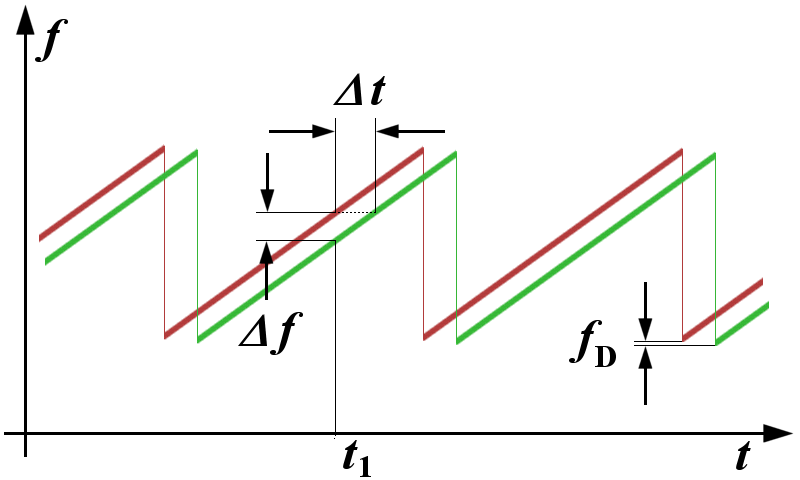|
Feed-through Null
Feed-through null follows the duplexer and is commonly used with continuous-wave radar to improve performance. Definition The transmitter is constantly issuing high power RF with continuous wave radar. Some of the transmit signal will leak into the receiver when the receive antenna is near the transmit antenna. The signal that leaks from the transmitter to the receiver is called bleed-through. Electronic circuits have limited dynamic range, and this reduces receiver sensitivity. Feed-through nulling significantly reduces the bleed-through signal, which can be used to increase receiver sensitivity in continuous wave radar. Operation There are two kinds of feed-through nuller. * Active * Passive Active A sample of the transmit signal is fed to an attenuator. The feed-through nuller samples the bleed-through signal arriving at the receiver. This bleed-through sample is amplified, filtered (low-pass), and this is used to drive the attenuator. Attenuator output is phase shifted ... [...More Info...] [...Related Items...] OR: [Wikipedia] [Google] [Baidu] |
Duplexer
A duplexer is an electronic device that allows bi-directional ( duplex) communication over a single path. In radar and radio communications systems, it isolates the receiver from the transmitter while permitting them to share a common antenna. Most radio repeater systems include a duplexer. Duplexers can be based on frequency (often a waveguide filter), polarization (such as an orthomode transducer), or timing (as is typical in radar). Types Transmit-receive switch In radar, a transmit/receive (TR) switch alternately connects the transmitter and receiver to a shared antenna. In the simplest arrangement, the switch consists of a gas-discharge tube across the input terminals of the receiver. When the transmitter is active, the resulting high voltage causes the tube to conduct, shorting together the receiver terminals to protect it, while its complementary, the anti-transmit/receive (ATR) switch, is a similar discharge tube which decouples the transmitter from the antenna while n ... [...More Info...] [...Related Items...] OR: [Wikipedia] [Google] [Baidu] |
Continuous-wave Radar
Continuous-wave radar (CW radar) is a type of radar system where a known stable frequency continuous wave radio energy is transmitted and then received from any reflecting objects. Individual objects can be detected using the Doppler effect, which causes the received signal to have a different frequency from the transmitted signal, allowing it to be detected by filtering out the transmitted frequency. Doppler-analysis of radar returns can allow the filtering out of slow or non-moving objects, thus offering immunity to interference from large stationary objects and slow-moving clutter. This makes it particularly useful for looking for objects against a background reflector, for instance, allowing a high-flying aircraft to look for aircraft flying at low altitude against the background of the surface. Because the very strong reflection off the surface can be filtered out, the much smaller reflection from a target can still be seen. CW radar systems are used at both ends of the range ... [...More Info...] [...Related Items...] OR: [Wikipedia] [Google] [Baidu] |
Continuous Wave Radar
Continuous-wave radar (CW radar) is a type of radar system where a known stable frequency continuous wave radio energy is transmitted and then received from any reflecting objects. Individual objects can be detected using the Doppler effect, which causes the received signal to have a different frequency from the transmitted signal, allowing it to be detected by filtering out the transmitted frequency. Doppler-analysis of radar returns can allow the filtering out of slow or non-moving objects, thus offering immunity to interference from large stationary objects and slow-moving clutter. This makes it particularly useful for looking for objects against a background reflector, for instance, allowing a high-flying aircraft to look for aircraft flying at low altitude against the background of the surface. Because the very strong reflection off the surface can be filtered out, the much smaller reflection from a target can still be seen. CW radar systems are used at both ends of the rang ... [...More Info...] [...Related Items...] OR: [Wikipedia] [Google] [Baidu] |
Band-stop Filter
In signal processing, a band-stop filter or band-rejection filter is a filter that passes most frequencies unaltered, but attenuates those in a specific range to very low levels. It is the opposite of a band-pass filter. A notch filter is a band-stop filter with a narrow stopband (high Q factor). Narrow notch filters (optical) are used in Raman spectroscopy, live sound reproduction (public address systems, or PA systems) and in instrument amplifiers (especially amplifiers or preamplifiers for acoustic instruments such as acoustic guitar, mandolin, bass instrument amplifier, etc.) to reduce or prevent audio feedback, while having little noticeable effect on the rest of the frequency spectrum (electronic or software filters). Other names include "band limit filter", "T-notch filter", "band-elimination filter", and "band-reject filter". Typically, the width of the stopband is 1 to 2 decades (that is, the highest frequency attenuated is 10 to 100 times the lowest frequency atten ... [...More Info...] [...Related Items...] OR: [Wikipedia] [Google] [Baidu] |


